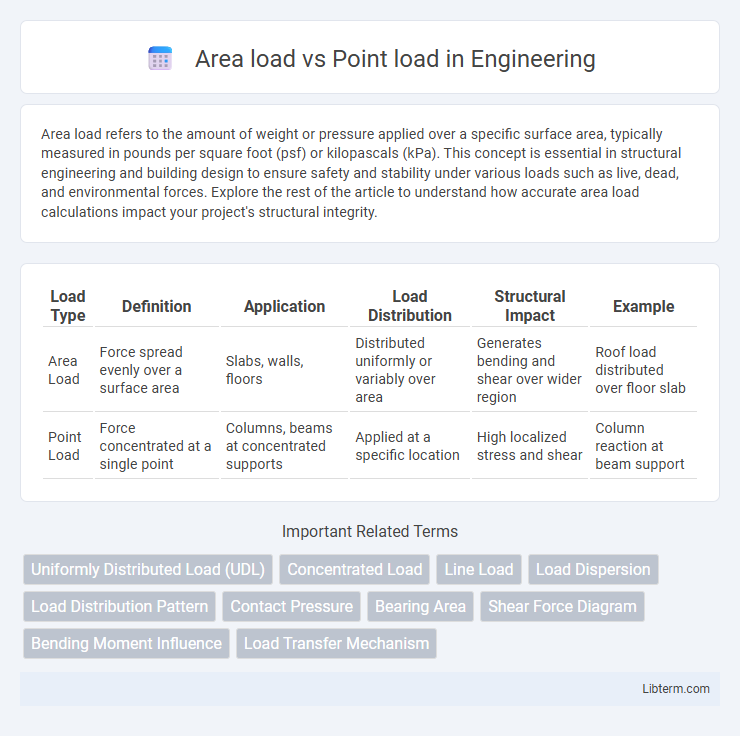Area load refers to the amount of weight or pressure applied over a specific surface area, typically measured in pounds per square foot (psf) or kilopascals (kPa). This concept is essential in structural engineering and building design to ensure safety and stability under various loads such as live, dead, and environmental forces. Explore the rest of the article to understand how accurate area load calculations impact your project's structural integrity.
Table of Comparison
| Load Type | Definition | Application | Load Distribution | Structural Impact | Example |
|---|---|---|---|---|---|
| Area Load | Force spread evenly over a surface area | Slabs, walls, floors | Distributed uniformly or variably over area | Generates bending and shear over wider region | Roof load distributed over floor slab |
| Point Load | Force concentrated at a single point | Columns, beams at concentrated supports | Applied at a specific location | High localized stress and shear | Column reaction at beam support |
Introduction to Area Load and Point Load
Area load refers to a distributed force applied over a specific surface area, commonly measured in units such as pounds per square foot (psf) or kilonewtons per square meter (kN/m2). Point load is a concentrated force applied at a single point or a very small area, typically measured in pounds (lbs) or kilonewtons (kN), causing localized stress in structural elements. Understanding the distinction between area load and point load is essential for accurate structural analysis and design.
Defining Area Load
Area load refers to a distributed force acting over a specified surface area, typically measured in units such as pounds per square foot (psf) or Newtons per square meter (N/m2). This type of load spreads the force evenly across the entire area, reducing stress concentrations compared to point loads. Engineers use area loads to analyze structural elements like floors, walls, and slabs where forces are not localized but spread over a region.
Defining Point Load
Point load refers to a concentrated force applied at a specific, singular point on a structure or surface, resulting in stress and deformation localized around that exact position. Unlike area load, which distributes force over a larger surface area, point load imposes higher stress intensity within a minimal contact area, often leading to critical structural analysis considerations such as shear force and bending moment calculations. Understanding the effects of point load is essential in engineering design to prevent material failure and ensure structural stability under concentrated forces.
Fundamental Differences Between Area Load and Point Load
Area load distributes force uniformly over a specific surface area, measured in units like pounds per square foot (psf) or kilonewtons per square meter (kN/m2), resulting in a spread-out pressure effect on structures. Point load concentrates the entire force at a single, precise location, quantified in units such as pounds (lb) or kilonewtons (kN), causing localized stress and potential deformation. The fundamental difference lies in how the load is applied and its impact on structural response, with area loads influencing broader regions and point loads creating intense stress at one point.
Applications of Area Loads in Structural Engineering
Area loads in structural engineering distribute forces over a surface, improving stability and reducing stress concentrations in slabs, walls, and foundations. Common applications include the design of floor systems subjected to live loads, roof structures exposed to snow loads, and retaining walls bearing soil pressure. Proper consideration of area loads ensures accurate load transfer, enhancing structural safety and performance under distributed weight conditions.
Applications of Point Loads in Structural Engineering
Point loads concentrate force at a single location, making them crucial in structural engineering for simulating concentrated stresses such as column loads or heavy machinery. These loads help engineers design beam supports and foundation footings by accurately predicting deflection and stress distribution at specific points. Applications include bridge pier supports, crane support beams, and concentrated load points in trusses or frames.
Calculation Methods for Area Load
Calculating area load involves distributing the total load uniformly over a specified surface, typically expressed in units such as pounds per square foot (psf) or kilonewtons per square meter (kN/m2). Methods include multiplying the area by the uniform load intensity to determine total load, which helps in structural analysis for slabs, floors, or walls subjected to distributed forces. Finite element analysis (FEA) and load combination techniques enhance accuracy by factoring variable load distributions and material properties within the area load calculation.
Calculation Methods for Point Load
Point load calculation methods primarily involve analyzing concentrated forces applied at specific locations on structures, using formulas derived from structural mechanics principles such as P = F/A for stress and bending moment equations for beam deflection. Techniques like the direct integration method, singularity functions, and the method of superposition help determine shear forces, bending moments, and deflections caused by point loads. Accurate point load calculations are critical for designing structural elements to ensure safety and compliance with engineering standards such as AISC and Eurocode.
Structural Impacts: Area Load vs Point Load
Area loads distribute force evenly over a surface, reducing stress concentrations and minimizing localized structural damage, which enhances overall stability and durability. Point loads concentrate forces at specific locations, increasing the risk of material deformation, cracking, or failure at those points due to high stress intensity. Understanding the differences between area and point loads is essential for designing structures that effectively manage load distribution and ensure safety under various loading conditions.
Choosing the Appropriate Load Type for Your Project
Choosing the appropriate load type for your project depends on the nature and distribution of the forces involved: area loads distribute weight uniformly over a surface, ideal for floors and slabs, while point loads concentrate force at specific locations, typical for columns or beams. Accurate load type selection ensures structural integrity and optimal material usage, preventing overdesign or underestimation of stresses. Engineers analyze project specifications, load distribution patterns, and support conditions to determine whether area or point loads better represent real-world forces.
Area load Infographic

 libterm.com
libterm.com